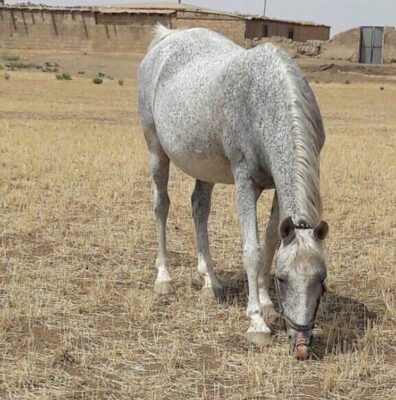كحيلة ابن مزهر في الجزيرة السورية توثيق محمد معصوم العاقوب مراجعة الشيخ هاشم الجربا
تُعتبر كحيلة ابن مزهر من الارسان الحديثة وهي بالأصل كروش
بطحها رجل من الجوالة من قبيلة طي يُقال له حماد الاسيود الخابور من رجل من الفدعان يُقال له ابن ماضي ثم اخذها من الجوالي ابن مزهر من اقارب شيخ طي انذاك محمد العبدالرحمن العساف توفّي نهاية اربعينيات القرن العشرين وهو الذي أطلق عليها اسم كحيلة ابن مزهر لأن الاعنزي اخفى نسبها عندما سُلبت منه
وبعد فترة من الزمن جاء الاعنزي الى شيخ طي يطلب فرسه فقال له الشيخ اذهب الى تلك الفيضة والخيل موجودة فيها إن عرفت فرسك فهي لك فذهب الرجل وجاء ثلاث رؤوس من الخيل تزيد او تنقص وبالفعل جميعهن من فرسه
سأله الشيخ كيف عرفتهن ؟
قال: قصر جين وبگاع عين
فقال له الشيخ نعطيك نصفهن بشرط ان تخبرنا اصلهن فقال الاعنزي هن من رسن كروش
وبقيت الخيل تتبارك عند مشايخ طي وعندما بدأ الواهو بالتسجيل تم قبول الخيل في المنظمة ودرجت من الشيخ محمد الفارس العبدالرحمن فرس الى نزار الاسعد اسمها مواضي
وفي عام 1983 أعطي عبدالعزيز المحمد العبدالرحمن مهرة لحمود الملحم الجرباء من مشايخ شمر وبينهم قرابة خولة ولحمود الجرباء ومن بعده ابنائه دور كبير في الحفاظ على هذه السلالة ونمت وتباركت عندهم تميّز من هذا المربط بطل السرعة هدّار وهيشان وبرزان وفرسي الانتاج لزاز ونوار والفرس الجميلة نوما
لزاز بنت كروش الناعم

I believe we need to name a Krush filly Crochet, as that is how Google Translate rendered it.
It still worked enough for me to get the gist of the article. And I love the photo. Translated as “the soft girl of Krush.”
lol, the mare is Lazaz, daughter (“bint” not girl) of the Krush stallion from the village of al-Na’em (Na’em can also mean “soft”)
The story sheds light on both strain formation and the grey zone between asil and not asil that results from slow information flows. Basically, a Tai man dismounted a Fad’aan Bedouin and stole his mare, in the 1920s or 1930s, and gave it to Ibn Mizhir.
In the absence of any information on the mare (strain, marbat, owner, etc), the Shaykh of Tai called it the “Kuhaylah of Ibn Mizhir”. In a sense it was overreach, because they did not even know that she was asil, and therefore a Kuhaylah.
A few years later, the Fad’aan Bedouin went to the Tai to claim the mare and any descendants back, and after recognizing the offspring one by one (3-4 of them in the pasture by then), he was offered to take half of them if he shared any info on the mare. This means that they had kept the mare and her offspring under a “pending” status. It also tells you how far the Tai were willing to go, foregoing several mares for a piece of information.
He told them the mare was a Krush (and perhaps some more details too, which the story does not account for). Still, the strain name Kuhaylat Ibn Mizhir stuck, even though the Krush strain was more prestigious.
That is a pretty mare!
The story really does demonstrate the complexity of tracing strain relationships by name. Would never have been able to tell that Kuhaylan ibn Muzhir was originally descended from a Krush!
Yes, a very pretty. The dark fleabites are charming. But I am stable-blind to a degree when it comes to the greys, I’ll freely admit.
The story is a fascinating one, Edouard — thank you very much for recontextualizing its significance in the comments to make sure those that do not read Arabic well are clear on its meaning. This certainly explains how mares like Rodania, Urfah, Roga El Beda, and Venus could have the same mitochondrial DNA but have different strains.